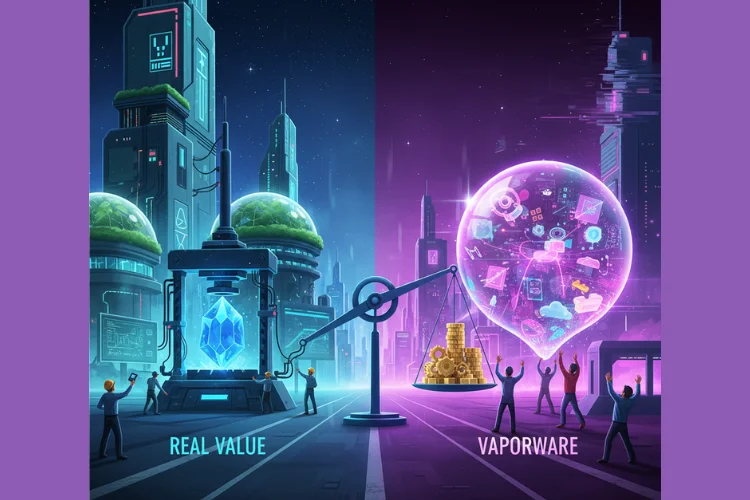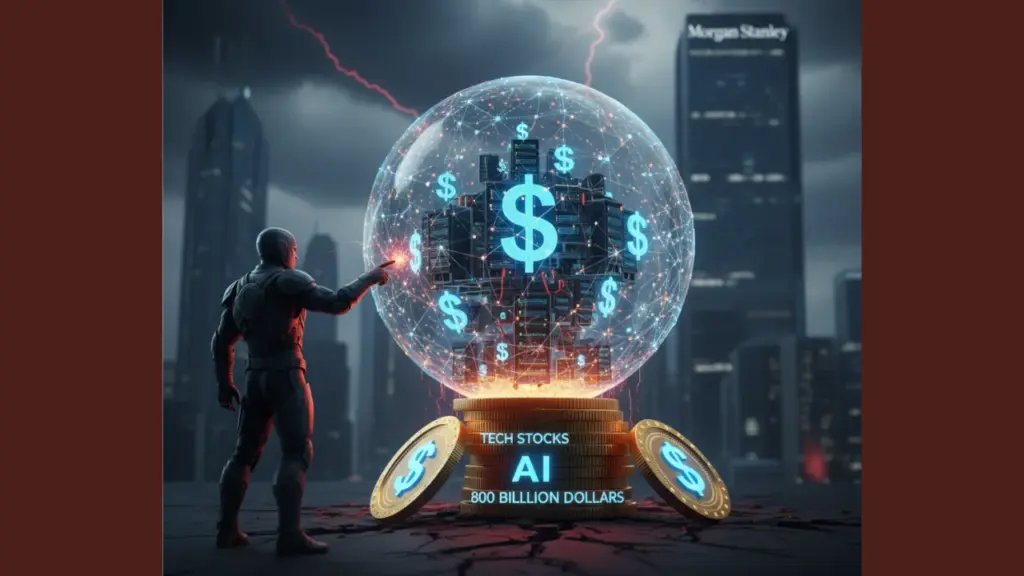1. Introduction: The AI Boom Everyone’s Talking About
Artificial Intelligence has become the heart of modern innovation. Every company wants to join the AI revolution. From startups to trillion-dollar tech giants, everyone is racing to integrate AI into their products, marketing, and operations.
Investors are pouring billions into AI tools, chips, and data infrastructure. The global narrative suggests AI will reshape everything — from how we code to how we communicate.
But amid the euphoria, Morgan Stanley has issued a chilling warning: the AI industry might be building a financial bubble as dangerous as the dot-com crash of the early 2000s.
The concern isn’t just about high valuations — it’s about how money circulates within the AI ecosystem. When AI companies are mainly selling to other AI companies, who is the real customer?
That’s the billion-dollar question no one wants to answer.
2. The $800 Billion Reality Check
Let’s start with the number that shook the industry: $800 billion.
According to Bain Capital, there’s going to be an $800 billion gap between what companies are spending on AI and what they’re actually making from it.
This means global enterprises are investing heavily in AI infrastructure — data centers, chips, software, and consulting — but very few are seeing measurable returns.
For many organizations, the race to adopt AI has turned into a spending spree without strategy. Boards and executives fear being left behind, so they invest aggressively — often without a clear understanding of ROI.
In short, the AI economy is booming in spending, but lagging in earnings. That’s a classic sign of a bubble forming beneath the surface.
3. The Circular Economy of AI: Companies Selling to Each Other
Morgan Stanley’s warning goes deeper. They’re not just worried about overspending — they’re alarmed by who is actually buying AI products.
Many AI companies are selling to… other AI companies.
It’s a self-reinforcing cycle:
- AI startups buy cloud services from big tech.
- Big tech buys AI models and data from those same startups.
- Both raise more funding to keep the cycle going.
On paper, it looks like massive growth. In reality, it’s a closed-loop system with limited outside demand.
This circular economy inflates the numbers — making the market seem larger than it truly is. And just like in the dot-com bubble, inflated demand can collapse fast once real customers stop buying.
When AI companies start depending on each other for revenue, it becomes a game of musical chairs. Everyone keeps dancing — until the music stops.
4. The Disconnect Between Hype and Reality
AI promises limitless potential. But the truth is — the business reality doesn’t match the hype.
Many AI tools are exciting demos that struggle to scale in the real world. Productivity gains remain uncertain. Most AI chatbots and copilots still depend on human oversight to avoid costly errors.
Meanwhile, startups claim billion-dollar valuations based on “future potential” rather than actual profitability.
This disconnect between valuation and value is dangerous. It creates the illusion of unstoppable growth while ignoring weak business fundamentals.
Investors are acting as if AI will instantly change the world. But in most industries, the adoption curve is slow, expensive, and complex. The hype cycle may be running ahead of practical reality.
5. Lessons from History: Dot-Com Déjà Vu
For those who remember the dot-com crash, the current AI frenzy feels familiar.
Back in the late 1990s, internet startups raised millions with nothing but a website and a dream. When the market realized those companies weren’t profitable, the bubble burst.
Today’s AI ecosystem mirrors that same pattern.
The formula is eerily similar:
- Massive investment based on hype
- Skyrocketing valuations without earnings
- Blind faith in “future growth”
Morgan Stanley’s analysis echoes this caution: “We’ve seen this before — the numbers just don’t add up.”
If AI companies don’t start delivering tangible returns soon, the correction could be harsh — and global.
6. The Role of Fractional CTOs in Navigating the Hype
This is where smart leadership becomes essential. Enter the fractional CTO — a part-time Chief Technology Officer who helps businesses make smarter, data-driven technology decisions without the full-time cost.
In an overheated market, a fractional CTO provides strategic clarity. They evaluate whether AI investments align with a company’s goals, budgets, and real use cases.
Here’s what they bring to the table:
- Objective analysis of whether an AI solution truly adds value.
- Technical expertise to separate hype from practicality.
- Strategic planning that ensures long-term sustainability.
While many companies rush into AI adoption, those guided by a fractional CTO can avoid costly mistakes.
Instead of buying AI just to appear “innovative,” they implement it where it truly matters — to boost productivity, enhance decision-making, or automate key business functions.
In short, fractional CTOs act as the reality check the AI industry desperately needs.
7. What Could Trigger the Collapse?
Morgan Stanley’s analysis highlights several warning signs that could trigger an AI market correction.
a. Slowing Demand
Once corporate budgets tighten, many organizations will scale back their experimental AI projects. Without steady demand, smaller startups could struggle to survive.
b. Investor Pullback
If investors stop believing in the exponential growth story, funding will dry up. Startups dependent on constant capital injections may collapse almost overnight.
c. Rising Costs
AI requires enormous compute power and energy. As costs rise, profit margins shrink. Even big players like Google and Microsoft are facing escalating infrastructure expenses.
d. Regulatory Pressure
New global regulations on data privacy, model transparency, and copyright could also slow AI development and limit profitability.
Each of these factors alone might not burst the bubble — but together, they could cause a chain reaction across the AI ecosystem.
8. The Future: Real Value vs. Vaporware
Despite the warnings, not all is doom and gloom. AI still holds massive potential — but only for companies that prioritize value over vanity.
The winners of this AI era will focus on:
- Solving real-world problems, not just building flashy tools.
- Delivering measurable ROI through automation, analytics, or user experience.
- Balancing innovation with responsibility, ensuring AI adoption is ethical and sustainable.
For example, companies using AI to enhance customer support, predict market trends, or optimize logistics are already seeing results.
Meanwhile, those building “AI for the sake of AI” may soon face tough questions from investors and customers alike.
The future of AI won’t be defined by who spends the most — but by who delivers the most practical impact.

9. Conclusion: The Calm Before the Storm?
Morgan Stanley’s warning isn’t just another bearish prediction — it’s a wake-up call.
The AI industry stands at a crossroads. It can either evolve responsibly or inflate itself into collapse.
To survive, companies must think beyond hype and focus on sustainable innovation. They need to measure returns, validate demand, and invest strategically.
This is where the guidance of fractional CTOs and experienced digital advisors becomes invaluable. They bridge the gap between visionary ideas and realistic execution.
The lesson is simple: the future belongs to businesses that build real value — not illusions.
As history has shown, every bubble eventually bursts. The question is not if, but when.
So, is this the calm before the storm? Or will the AI industry learn from its past before it’s too late?
At StartupHakk, we continue to explore these critical shifts shaping technology, innovation, and leadership. Because in an era driven by algorithms and hype, understanding reality might just be the smartest investment of all.




